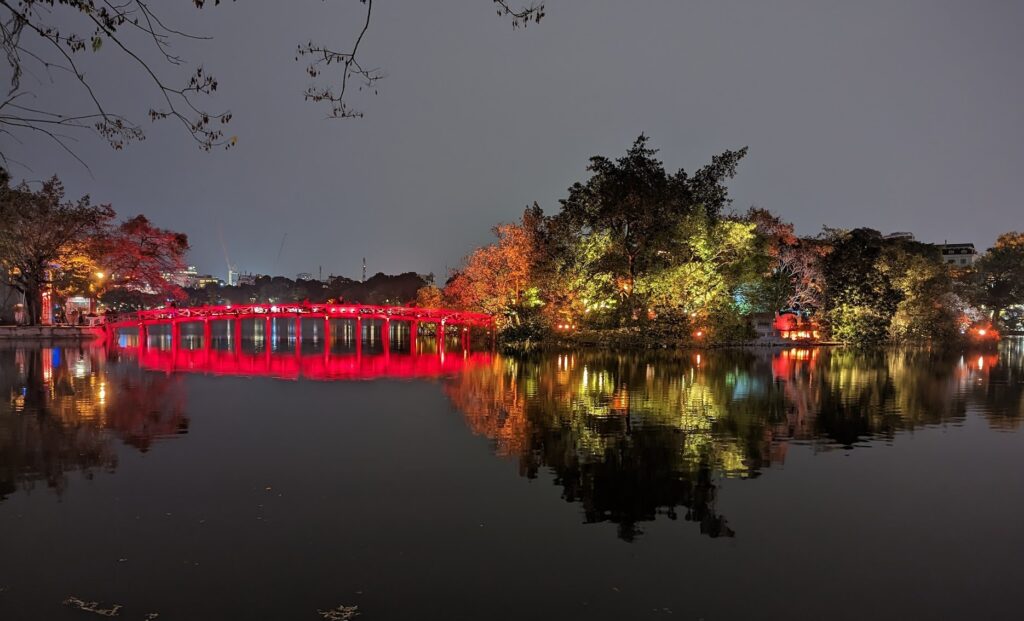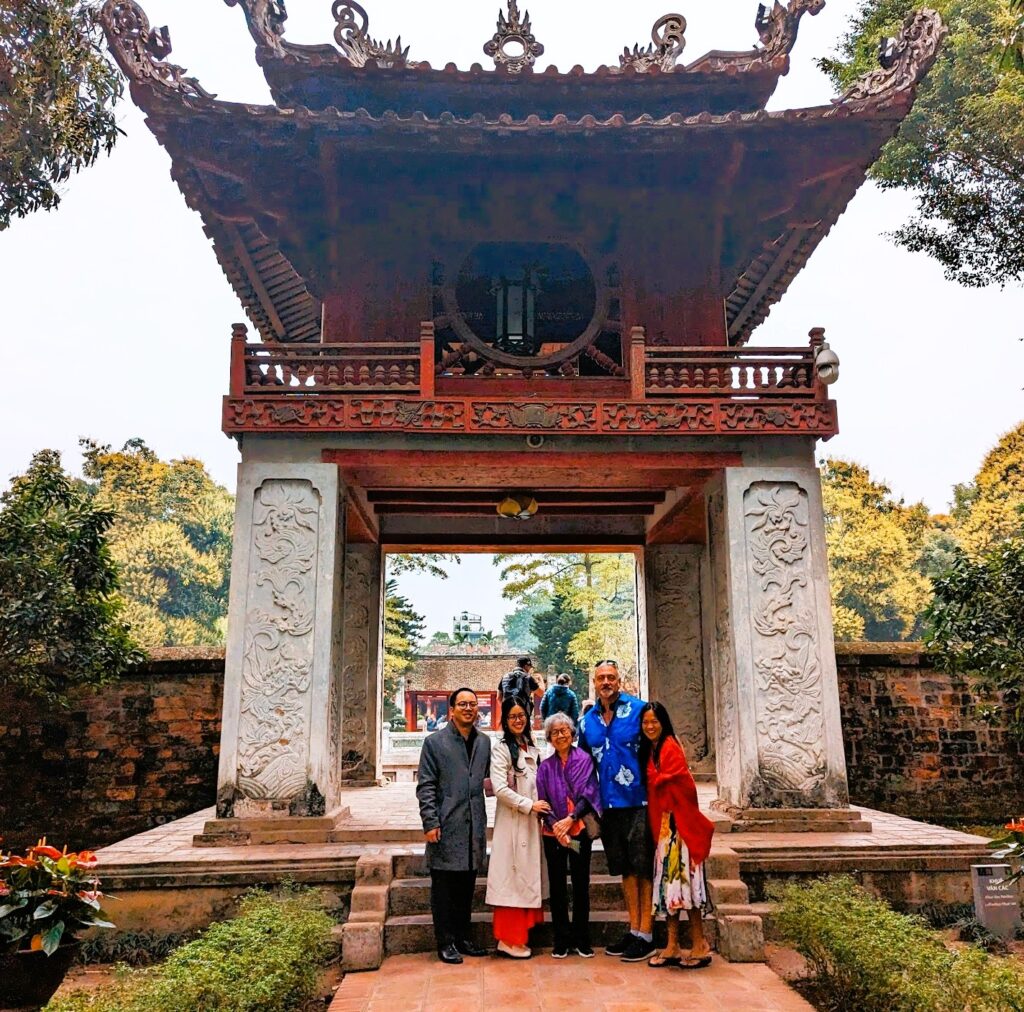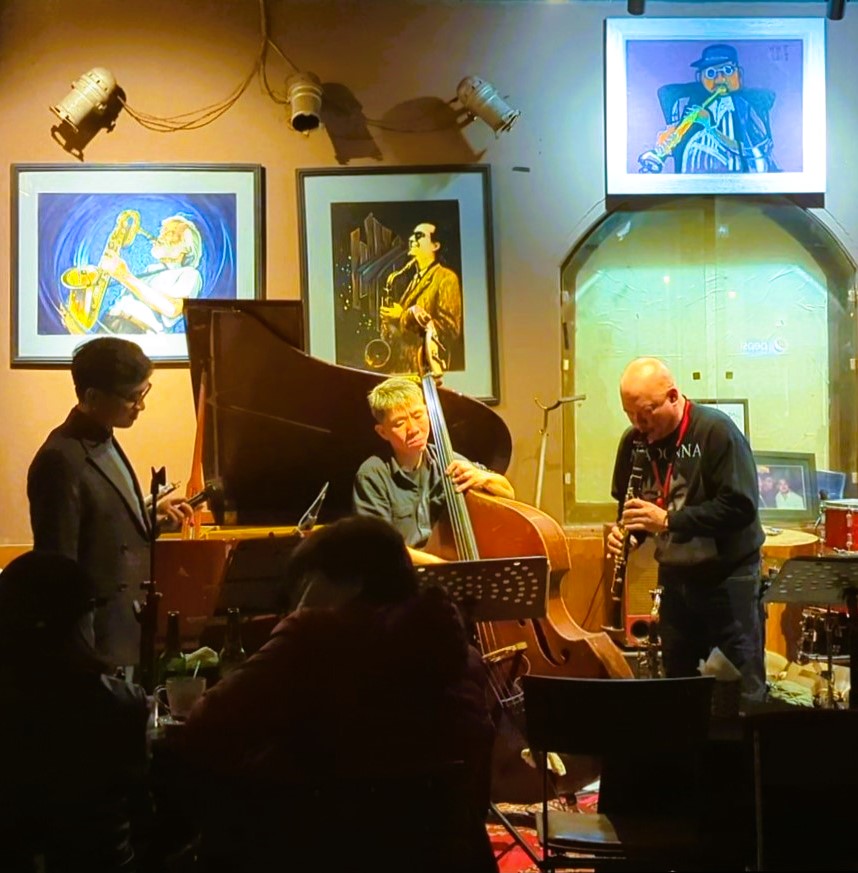
A Hanoi Homecoming – by Deborah Brand Probst
One of my earliest travel memories as a child involves staring through a 2-inch hole in the floor of a taxi as it hurtled down the road from the airport of what was then Saigon. I was 3 years old, embarking on my first trip to visit my grandmother. The hole was large enough for me to fit my little hand through, and I was sorely tempted to reach out and touch the road. Luckily, I was distracted by the chaotic scene unfolding outside: baskets artfully balanced on bicycles concealing their diligent riders, small children clinging to their parents on scooters meant for one, trucks laden with food, cars in various states of disrepair dodging traffic, and the ever-present cyclists, patiently and serenely transporting their passengers through a cacophony of honking horns and screeching tires.

Comparatively, the street where my grandmother lived seemed like an oasis of tranquility. The silence was mostly broken by the sounds of food vendors. In the morning, the air was filled with the aroma of freshly baked French bread; “banh cuon,” a wide rice noodle served with a fish sauce, lime, and chili concoction, topped with fried shallots and green onions; and breakfast “banh mi” sandwiches made with the same French bread and stuffed with assorted meats and pickled vegetables. In the afternoon, the culinary symphony resumed with the enticing aromas of tea time treats. I would eagerly await the arrival of the dessert tofu pudding. Once, my mother bought “balut,” fertilized duck eggs, which are known by that name in the Philippines. She accidentally dropped one in the sink, and the vision of the developing chick that fell out of the cracked egg still haunts me to this day. I’ve savored many interesting dishes in my life, but I have never mustered the courage to try “balut.”


Some Things Never Change
Though I wouldn’t touch the balut, I devoured everything else. The aroma of freshly baked French bread, the omnipresence of pungent fish sauce, and the refreshing taste of cold noodles, perfect for a hot and humid day, remain indelibly etched in my memory.
Fifty-one years later, these sensory experiences are still vividly present, now artfully presented in tourist-oriented restaurants with trendy names – a testament to the fact that Vietnamese cuisine has joined the ranks of sushi and Thai food, gaining widespread acceptance and reverence in many parts of the Western world. This is certainly true in Houston, where my mother now resides, home to one of the largest Vietnamese populations outside of Vietnam.
On this trip, we followed in my mother’s footsteps, seeking out places to savor our favorite dishes. We indulged in the ubiquitous Banh Mi, Vietnam’s iconic version of the submarine sandwich. Filled with a savory medley of pork fillings, pâté, crisp pickled vegetables, and a mysterious concoction of soy sauce, Maggi sauce, and fish sauce, no two Banh Mi are ever the same.
We discovered a charming restaurant specializing in Cha Ca, a delightful grilled fish dish seasoned generously with turmeric, nestled within an old mansion and surrounded by a lovely garden. The Cha Ca is served with a plethora of fresh herbs, peanuts, and, of course, the quintessential fish sauce dip.
Another memorable dining experience was at Tam Vi, a gorgeous little restaurant meticulously decorated in a traditional style. Our gracious hosts, who had invited us to visit the Temple of Literature, introduced us to this gem. From the cascading plants and koi pond gracing the terrace garden to the artful treasures adorning the bookshelves within, every detail exuded a sense of refined elegance. Located on a small, unassuming alley near Hanoi’s West Lake, we luxuriated in a leisurely 2.5-hour lunch.
The menu featured culinary delights such as perfectly cooked clay pot pork belly, tender and sweet cold prawns served with crisp lettuce for wrapping, and a generous array of fresh herbs and spices for dipping to one’s heart’s content. The fried tofu, prepared fresh, was an absolute revelation. Succulent and soft, it was airy in the center yet delightfully crispy on the edges. I still marvel at how such a harmonious blend of textures can be achieved in a single dish.
Since our visit, Tam Vi has earned the auspicious distinction of a Michelin star, likely soon to be overrun by global hipsters. We are delighted for them, but grateful to have enjoyed the restaurant to ourselves on that particular day.
Our guide for the Temple of Literature is a leading translator of Vietnamese literature worldwide. His connection to my mother stems from his dedicated search for my mother’s late husband, a distinguished scholar in the field of classical Chinese and Vietnamese literature. They would spend countless hours engaged in lively debates, often delving deep into the nuances of classical texts, discussions that sometimes stretched on for days, even months.
My stepfather passed away a few years ago, and Dan, now married and residing in Vietnam, graciously extended an invitation for us to tour the Temple. His wife, the special events program director for the temple tours, met Dan when he was a special guest at a temple engagement. They are now married and expecting a child. To my mother, it was simply “one of the students” who was going to guide us through the temple and treat us to lunch. To the temple staff, we were considered “special guests.” Little did we know that this “lunch” would be at a Michelin-starred restaurant.
The next day, we were warmly welcomed into their home for a traditional Bun Cha meal. A cornerstone of Vietnamese cuisine, Bun Cha is a refreshing cold noodle dish served with tender grilled pork, accompanied by the ubiquitous lettuce, pickled vegetables, an array of dipping sauces, and a side of watercress soup. It exemplifies the timeless appeal of comfort food, a simple yet sublime culinary experience that transcends cultural boundaries.
Their family home was a treasure trove of antiques and relics from generations past. Now, these cherished possessions are displayed along the silent walls of a spacious living room, resembling the lobby of a museum. However, instead of sterile museum displays, we were graciously served multiple cups of tea before enjoying a sumptuous lunch at the grand dining table, a table that has undoubtedly witnessed countless family gatherings.

Past and Present
My mother is now 81, living thousands of miles away from Hanoi. Uncertain how many more trips like this we’ll share, we indulged her whims and visited the neighborhood of her childhood. We strolled through the streets, listening to her recount memories of childhood – of shuffling notes from her grandfather’s house to the residence across the street where her uncle’s girlfriend lived, and watching him play marbles on the sidewalk.
She vividly recalled the vibrant scene of her youth: flowers cascading down balconies, a beautiful garden surrounding the three-story house, resplendent with songbirds and the intoxicating aroma of tropical blooms on a hot, humid Hanoi afternoon.
Now, the scene is a stark contrast. Electrical wires snake across the faded façade, and the once-verdant garden is replaced by a nail salon. In a bittersweet twist, we decided to indulge in a manicure, a modern touch in a place steeped in her childhood memories.
Hanoi’s Blue Note
These days, Mom goes to bed early. So after a very rigorous two-mile walk from her old neighborhood back to the hotel, I drop off a banh mi for her as she settles in for the night. Mark and I then head to Binh Minh jazz club, where the music is scorching hot, the beers deliciously cold, the bartender friendly and welcoming, and the star saxophonist/part-owner is as cool as the other side of the pillow.
After a couple of sets, we wander off to the appropriately named Beer Street on a Saturday night. This touristy spot strongly resembles Khao San Road in Bangkok, Patong Beach in Phuket, Kuta in Bali, Sihanoukville in Cambodia, and the myriad of copycat hot spots that have proliferated throughout Southeast Asia. Teeming with colorful pubs, massage parlors, street food vendors, hostels, and buskers, it’s a festive and bustling scene most nights. The uniform of choice for tourists here seems to be an oversized backpack.
As usual, Mark effortlessly makes friends with a group of Vietnamese tourists. They are captivated by his size, his loud, booming, and friendly American voice, his willingness to converse in Vietnamese, and his impressive ability to keep up with them as they partake in shot after shot of questionable Vietnamese whiskey and tiny beers. Little do they realize they are dealing with a seasoned professional. I leave them there at the wee hours of 2:00 AM and wander home, carefully navigating around scurrying rats and the shopkeepers who are hosing down the sidewalks, preparing to shut down for the evening and gearing up for the next day of adventures.



